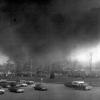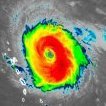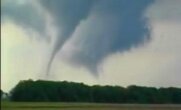-
Posts
1,430 -
Joined
-
Last visited
About Buckeye05

Profile Information
-
Four Letter Airport Code For Weather Obs (Such as KDCA)
KFFO
-
Gender
Not Telling
-
Location:
Beavercreek,OH
Recent Profile Visitors
2,706 profile views
-
It should be known that this one of the excuses Robinson used to keep Vilonia at EF4, though it wasn't valid even if that was a real rule, as there were at least two homes that met the anchoring and contextual criteria for EF5. Good to see someone officially put that utter bs to rest though.
-
I appreciate you taking the time to read. I have only heard of one tornado that has been upgraded years after it occurred since the 2007 implementation of the EF scale, which was the Bellemont, Arizona tornado of October 6, 2010. It was upgraded from EF2 to EF3 last year. So while it is almost unheard of, we do have one recent example of precedence to show that it is possible. While it's nice to hope, I strongly doubt that a rating change will happen. It isn't going to be a high priority objective, and given the fact that LZK staunchly defended their decision when people criticized them, it isn't going to be a "good look" for them if they suddenly start backpedaling and admitting it was a bad call years after the fact. Humans are involved, so pride/ego is going to be a factor, whether anyone wants to admit that or not. I give the probability of a thorough re-analysis being done as about 1% or less.
-
Please check your DMs. I sent you some important stuff.
-
The lead surveyor for LZK Vilonia survey was a guy named John Robinson, and he has since retired, so I don't think Cavanaugh would have much to say about it. Plus, LZK has caught a ridiculous amount of flak over the years from angry weather geeks bashing and criticizing them over that rating. I'm sure that any email containing the words "Vilonia" that shows up in an inbox at that particular WFO, is gonna go right into the deleted folder. But anyway, it would be more productive talking to a brick wall than it would be talking to Robinson about this, as he has strongly insinuated in interviews that he does not believe in applying EF5 ratings to houses. It's suspected by some that the botched results of the Vilonia survey occurred as a result of Robinson perpetuating his highly skewed interpretation of the EF scale into actual practice. I will DM and give you a run-down of that whole debacle, as it seems you are just now learning about the infamous Vilonia survey. It's truly astonishing how bad they failed at documenting the first true instance of EF5 damage within the state of Arkansas.
-
Nah, he believes in what he is saying. It doesn't hold much water, but I think it's coming from a place of sincerity though.
-
Sure, I'll do it. But what I am saying is that other people who have tried to contact him about that particular event either get stonewalled, or dismissed with a brief reply saying that he is not privy to information regarding the areas of potential EF5 house damage in Vilonia. I don't see why me contacting him would yield a different result. But, yeah for the sake of thoroughness I will send him an email.
-
When asked about Vilonia, all Tim will say is that he didn’t survey those houses in question. No further elaboration. That is not good enough. You’re referring me to someone who’s answer is “idk”, just so you’re aware. You’re acting like he’s this all-knowing authority (which I once believed too, to be fair), and he’s just not when you apply objective scrutiny to some of his work, such as Vilonia and the recent Kentucky tornado. Outsourcing? Nah. Over-utilization of a strictly engineering approach? Absolutely. Not going down the way I initially said, but essentially the same end result. But yeah keep clinging to that one thing I got wrong, while disregarding all the highly troubling, verifiable information that I provided. How can you justify the strength of your belief in WFO survey teams and people like Marshall, when things like Vilonia happen? I think it’s because you’re not aware. I encourage you to actually take a look at cases like Vilonia yourself, instead of immediately defaulting to the word of people who claim to have dismissed the concerns.
-
Also yeah, I wasn’t right about the extent of influence that engineering firms have on surveys, but I guess that invalidates all the other verifiable information I provided regarding other questionable surveys. I do know that according to NWS Louisville, that engineers assisted with the recent Bowling Green survey, and when that WFO was asked a valid question about why an anchored DOD 10 residence was given an EF2 rating (which is below the lower-bound for that DI, and is technically breaking the guidelines set in place by the scale), they just said that this is likely the conclusion engineers that were consulted to assist with the survey came to, with no further explanation, as if it was out of their hands. That isn’t going to sit well with some people. But yeah, I’ll admit when I’m wrong. I can see you being able to do the same is struggle though.
-
Tim Marshall failed to survey or address multiple areas of potential EF5 damage in Vilonia, AR, and instead tried to put the issue to rest by only addressing all the slabbed, cut-nailed cookie cutter homes in the Sherwood Meadows subdivision as if that was the main area in question, when it wasn’t, and as if the general public didn’t understand the concept of poor construction. In fact, only one of the areas in question (E Wicker St) was addressed by the LZK survey, and the reasons given to keep it below the EF5 threshold were not valid (purported debris loading but with no traceable object in question striking the house, “inconsistent” tree damage that was a full 100 yards away from the house in question, and straight-nailing, even though several of the EF5 rated homes after Moore 2013 were straight nailed, and even though well-respected NWS damage surveyor Kiel Ortega established that single family homes with straight-nailed wall studs are still eligible for an EF5 rating given enough contextual support, within his survey of Moore 2013.) That E Wicker house had extensive, above and beyond anchoring of its exterior and interior walls too. The contextual damage was remarkable too. The reasons given, were more like excuses when you compare them to precedents set by previous EF5 events, and when compared to published guidelines given by Marshall himself on the subject of distinguishing EF4 from EF5 damage. The rest of the areas in question (S Coker Rd, Cemetery St, and Fish Hooks Restaurant) were completely omitted from not only Tim Marshall’s survey, but the LZK survey team. Don’t believe me? Look yourself. At least one resident who’s extensively anchored, modern home was completely slabbed, did confirm that neither the NWS survey team or any other survey team stopped by his property. They got skipped, along with other areas of the path. Those areas contained likely EF5 damage. These are facts, whether you want to believe them or not, and there are reasons why having unwavering faith in these people is a misinformed point of view. Bottom line, questionable practices are rampant when it comes surveys and ratings, and if you don’t see that, it’s because you aren’t taking a hard, objective look at the more controversial cases, and you aren’t aware of a lot of troubling information, and I can say that with a high degree of certainty.
-
You are dodging his questions and it’s painfully obvious whether you realize it or not. Bottom line, why are there massive gaps in the DAT survey, and why is it clear that in some areas (Lake Barkley) that the survey by driving through, snapping photos out of the window of their car windows, by all appearances not leaving their vehicle to inspect the construction of homes in that area? You have continued to regurgitate the same statements without addressing any of the very-much valid questions. Your blind faith in various people with big names in the damage surveying area of the field, along with ignorance to how misused the EF scale has become (I’m not going to spoon-feed you the endless examples of inconsistency and contradictions if you’re going to just arrogantly disregard anything that doesn’t line up with your viewpoint), is symptomatic of a larger issue.
-

December 15th-16th Warmth, Wind, and Severe Threat
Buckeye05 replied to Geoboy645's topic in Lakes/Ohio Valley
We are at 54 confirmed tornadoes, including 20 EF2s from this event! Totally insane. -
A perfect example is the Marshalltown, IA EF3 of 2018. Most of the path through the town was EF2, with some isolated EF3. Definitely not a violent tornado. Yet, when it hit the Lennox plant in town, it flattened large portions of the structure and metal frame to the ground, and twisted numerous beams and girders. I guarantee the tornado didn’t suddenly reach EF5 strength over that plant while causing lesser damage elsewhere. There are so so so many examples of moderately intense tornadoes demolishing industrial buildings and I don’t have time to list all the examples. You just have to pay attention, and I guarantee you’ll notice the same pattern I mentioned. It’s not really debatable once you start cataloging tornado events in your brain over the years.
-
I mean logic wise it all adds up, but after almost two decades of tracking tornado events, I can say with a high degree of confidence that a mangled industrial building does not = EF5 damage. I’ve seen far too many moderately strong tornadoes twist them up bad, while causing moderate structural damage elsewhere. I don’t think there’s an epidemic of tornadoes reaching EF5 strength directly over industrial buildings, only to be weaker everywhere else along the path. If what you are saying is true, there’d be violent damage surrounding every metal warehouse that’s been destroyed in a tornado, and there simply isn’t. There’s a difference between what you’re describing, versus what actually happens.
-
To be fair, metal warehouse buildings tend to "catch" wind due their lack of interior walls, sharp angles, and wide, flat surface areas, which act as a sail once wind enters the building. Once that happens, the metal exterior sheeting comes off, and the entire metal frame of the building warps, twists, and sometimes causes the overhead metal framing to collapse like dominos. There's a big difference between a metal-framed warehouse building and a metal-framed institutional building, and while the scale is indeed flawed, these two structure types are listed as separate DIs for good reason. Next time there's an EF2 or EF3 in a populated area, compare the damage to metal warehouses along the path to other structures with different construction methods. You'll see that the metal buildings always end up being mangled quite badly, while others nearby may only sustain roof loss. I've seen EF2s move through neighborhood and cause moderate to heavy damage to frame homes, but not totally destroy them, then essentially demolish a metal warehouse in the immediate vicinity. This is no fluke. Truly violent metal warehouse damage only really occurs when the metal support beams themselves are sheared off at their anchor plates, and the entire framing system is pushed or twisted off the foundation. I don't see anything like that in the above photo. To find damage like that, you have to look at events like Parkersburg, Guin, Van Wert, and most infamously Niles/Wheatland.
-
The only one that was entirely based on ground scouring was the Philadelphia, MS EF5. It dug deep trenches into the ground, which was assumed to have been indicative of 200+ MPH winds back in 2011. Unfortunately, there isn't a "ground scouring" DI, and since NWS many survey teams are much less open to factoring in non-established DIs and contextual evidence in this day and age, such a thing is not going to be a clincher for an EF5 rating anymore. In fact, it might not be factored in at all. Also, yes, the recent Kentucky tornado did produce the same kind of scouring.









